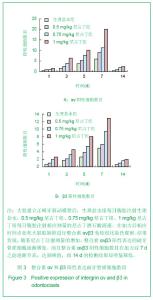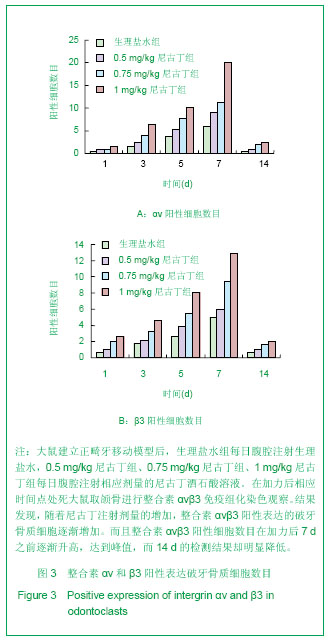Chinese Journal of Tissue Engineering Research ›› 2013, Vol. 17 ›› Issue (20): 3658-3665.doi: 10.3969/j.issn.2095-4344.2013.20.007
Previous Articles Next Articles
Nicotine inhibits root resorption induced by experimental tooth movement in rats
Zulihuma•Arefujiang1, Pan Xu1, 2, Mi Cong-bo1, 2
- 1 Department of Orthodontics, the First Affiliated Hospital of Xinjiang Medical University, Urumqi 830054, Xinjiang Uygur Autonomous Region, China
2 Department of Orthodontics, Stomatology College of Xinjiang Medical University, Urumqi 830054, Xinjiang Uygur Autonomous Region, China
-
Received:2012-12-07Revised:2012-12-27Online:2013-05-14Published:2013-05-14 -
Contact:Mi Cong-bo, Chief physician, Master’s supervisor, Department of Orthodontics, the First Affiliated Hospital of Xinjiang Medical University, Urumqi 830054, Xinjiang Uygur Autonomous Region, China; Department of Orthodontic, Stomatology College of Xinjiang Medical University, Urumqi 830054, Xinjiang Uygur Autonomous Region, China mi670105@sina.com -
About author:Zulihuma?Arefujiang★, Studying for master’s degree, Physician, Department of Orthodontics, the First Affiliated Hospital of Xinjiang Medical University, Urumqi 830054, Xinjiang Uygur Autonomous Region, China Pan Xu★, Master, Attending physician, Department of Orthodontics, the First Affiliated Hospital of Xinjiang Medical University, Urumqi 830054, Xinjiang Uygur Autonomous Region, China; Department of Orthodontic, Stomatology College of Xinjiang Medical University, Urumqi 830054, Xinjiang Uygur Autonomous Region, China Zulihuma?Arefujiang and Pan Xu contributed equally to this paper. -
Supported by:Special Fund for Young Researchers of the First Affiliated Hospital of Xinjiang Medical University, No. 2011QN05Z
CLC Number:
Cite this article
Zulihuma•Arefujiang, Pan Xu, Mi Cong-bo. Nicotine inhibits root resorption induced by experimental tooth movement in rats[J]. Chinese Journal of Tissue Engineering Research, 2013, 17(20): 3658-3665.
share this article
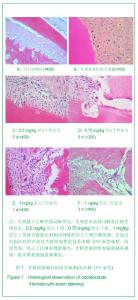
2.1 实验动物数量分析 实验选用110只SD大鼠中,死亡2只,其中生理盐水组和0.75 mg/kg尼古丁组各1只,死亡原因均为麻醉意外死亡。均在死亡后再次造模以保证数量,进入结果分析110只。 2.2 苏木精-伊红染色观察结果 空白对照组:牙根表面平滑,牙周膜纤维排列整齐,张力侧与压力侧牙周膜间隙均等,见图1A。 生理盐水组:加力1 d时,张力侧牙周膜纤维拉长,牙周膜间隙增宽;压力侧牙周膜间隙变窄,牙周膜纤维排列开始紊乱,牙骨质表面出现较小的吸收陷窝。加力3 d时,牙根表面吸收陷窝加深、变大,破牙骨质细胞增多。加力5 d时,根分叉处出现骨吸收陷窝和破牙骨质细胞,见图1B。加力7 d时,牙根压力侧、张力侧和根分叉处都出现吸收陷窝,并且增多加深,根分叉处出现大量破牙骨质细胞。加力14 d 时,破牙骨质细胞大量减少,牙根表面可见成牙骨质细胞,牙骨质吸收陷窝内出现新生的修复性牙骨质层。 0.5 mg/kg尼古丁组:组织学改变与生理盐水组大致相同。与相同加力天数相较,破牙骨质细胞更多,吸收陷窝更多且更深。5 d时根分叉处的吸收陷窝与生理盐水组相比,深度已达牙本质浅层,破坏更大,见图1C。 0.75 mg/kg尼古丁组:加力3 d时,牙根压力侧表面、根分叉处牙根表面均出现牙骨质吸收陷窝。吸收陷窝内的破牙骨质细胞数量比生理盐水、0.5 mg/kg尼古丁组增多,并可见炎性细胞侵润。加力5 d时,根分叉处出现较大的吸收陷窝及大量破牙骨质细胞,见图1D。 1 mg/kg尼古丁组:与其他实验组相比较,各个加力时间点上,1 mg/kg尼古丁组牙根表面的吸收陷窝明显增多加深,破牙骨质细胞显著增加。吸收陷窝附近的成纤维细胞排列不规则,大量炎性细胞浸润,见图1E。根分叉处牙骨质破坏显著,并有吸收陷窝深入牙本质内。根尖遭到破坏,见图1F。"
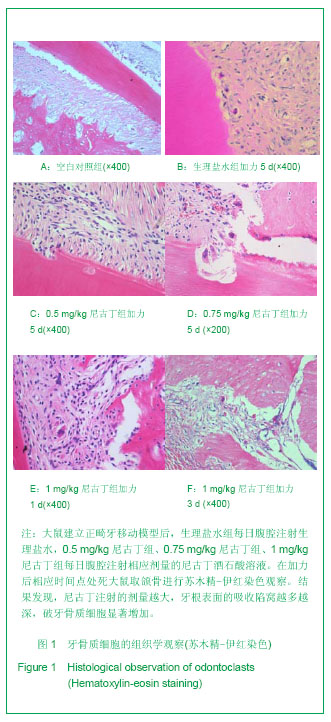
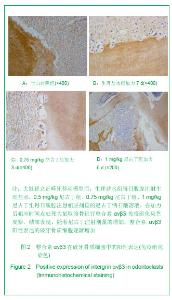
2.3 整合素αvβ3免疫组化阳性表达结果 空白对照组:未见整合素αvβ3阳性染色的破牙骨质细胞,见图2A。 生理盐水组:在加力1 d时,牙根压力侧偶见有浅棕色染色的破牙骨质细胞,并随着加力天数的增加,压力侧牙根表面的阳性破牙骨质细胞数目逐渐增加,染色逐渐加深,并在第7天时达到顶峰,强阳性表达的破牙骨质细胞深棕染色,见图2B。加力14 d时阳性破牙骨质细胞又出现大量减少。 0.5 mg/kg尼古丁组:与生理盐水组相比,0.5 mg/kg尼古丁组在加力的各个时间点,阳性表达的破牙骨质细胞数目增多,加力14 d时,阳性表达的破牙骨质细胞数量较少。 0.75 mg/kg尼古丁组:加力3 d时,牙根表面就出现大量阳性表达的破牙骨质细胞,且染色加深,见图2C。加力7 d时达到顶峰,加力14 d时,阳性表达的破牙骨质细胞的数量出现大幅减少。 1 mg/kg尼古丁组:阳性表达的破牙骨质细胞在各个加力时间的变化趋势与其他各实验组相似,但破牙骨质细胞数目与其他实验组相比显著增加、染色加深,加力5 d时就已有大量强阳性表达的破牙骨质细胞,见图2D。"

| [1] Fu MK. Orthodontics. Beijing: Renmin Weisheng Chubanshe. 2007:5.傅民魁.口腔正畸学[M].北京:人民卫生出版社,2007:5.[2] Mi CB,Fan XL,Tian Y,et al. Shanghai Kouqiang Yixue. 2010; 20(11):622-625.米丛波,范雪兰,田英等.乌鲁木齐市562例汉族青少年正畸需要量的研究[J].上海口腔医学,2003,12(1):11-13.[3] Buttke TM, Proffit WR. Referring adult patients for orthodontic treatment . J Am Dent Assoc. 1999; 130(1): 73-79.[4] US Centers for Disease Control and Prevention.Tobacco use, access, and exposure to tobacco in media among middle and high school students: United States, 2004. J MMWR Morb Mortal Wkly Rep. 2005;54(12):297-301.[5] Brunner H, Cockcroft JR, Deanfield J, et al. Endothelial function and dysfunction. Part II: Association with cardiovascular risk factors and diseases. A statement by the Working Group on Endothelins and Endothelial Factors of the European Society of Hypertension. J Hypertens. 2005;23(2): 233-246.[6] Mallampalli A, Guntupalli KK. Smoking and systemic disease. J Clin Occup Environ Med. 2006;5(1):173-192.[7] Huncharek M, Haddock KS, Reid R, et al. Smoking as a risk factor for prostate cancer: a meta-analysis of 24 prospective cohort studies. J Am J Public Health. 2010;100(4):693-701.[8] Yuhara S, Kasagi S, Inoue A, et al. Effects of nicotine on cultured cells suggest that it can influence the formation and resorption of bone. J Eur J Clin Pharmacol. 1999;383(3): 387-393. [9] Ramanathan C, Hofman Z. Root resorption relation to orthodontic tooth movement. J Acta Medica (Hradec Kralove). 2006;49(2):91-95.[10] Wang Z, Jin SM, Zhang J. Guoji Kouqiang Yixue Zazhi. 2010; 37(1):101-105.王智,靳淑梅,张君.牙根吸收的原因与机制[J].国际口腔医学杂志, 2010,37(1):101-105.[11] Pan X, Mi CB, Liu H, et al. Zhongguo Zuzhi Gongcheng Yanjiu yu Linchuang Kangfu. 2011;15(20):3737-3740.潘旭,米丛波,刘红等.正畸牙移动过程中牙周组织白细胞介素8的表达[J].中国组织工程研究与临床康复,2011,15(20): 3737-3740.[12] Liu C, Zhao F, Li QZ. Shengwuxue Zazhi.2012;29(1):75-78.刘畅,赵锋,李庆章.整合素在细胞黏附中的生物学功能[J].生物学杂志,2012,29(1):75-78.[13] Talic N, Evans CA, Daniel JC, at al. Immunohistochemical localization of alphavbeta3 integrin receptor during experimental tooth movement. J Am J Orthod Dentofacial Orthop. 2004;125(2):178-184.[14] Talic NF, Evans C, Zaki AM. Inhibition of orthodontically induced root resorption with echistatin, an RGD-containing peptide. J Am J Orthod Dentofacial Orthop. 2006;129(2):252-260.[15] Sun XM,Sun XH. Shiyong Kouqiang Yixue Zazhi. 2007; 23(2): 252-255.孙秀梅,孙新华.整合素αvβ3在实验性牙移动牙周组织骨改建中的表达[J].实用口腔医学杂志,2007,23(2):252-255. [16] Henningfield JE, Goldberg SR. Progress in understanding the relationship between the pharmacological effects of nicotine and human tobacco dependence. J Phar- macol Biochem Behav. 1988;30(2):217-220.[17] Haffajee AD, Socransky SS. Relationship of cigarette smoking to attachment level profiles. J Clin Periodontal. 2001; 28(4):283-295.[18] Baljoon M, Natto S, Bergström J. Long-term effect of smoking on vertical periodontal bone loss. J Clin Periodontol. 2005; 32(7):789-797.[19] Fisher MA, Taylor GW, Shelton BJ, et al. Predictive values of self-reported period- ontal need: National Health and Nutrition Examination Survey III. J J Periodontal. 2007;78(8): 1551-1560.[20] Gomes SC, Non NC, Susin C, et al. The effect of as upragingival plaque- control regimen on the subgingival microbiot a in smokers and never-smokers: evaluation by real-time polymer as a chain reaction. J Periodontal. 2008; 79(12):2297-2304.[21] Oshiro T, Shibasaki Y, Martin TJ, et al. Immunolocalization of vacuolar-type H+-ATPase, cathepsin K, matrix metalloproteinase-9, and receptor activator of NF kappaB ligand in odontoclasts during physiological root resorption of human deciduous teeth. J Anat Rec. 2001;264(3):305-311.[22] Sodagar A, Donyavi Z, Arab S, et al. Effect of nicotine on orthodontic tooth movement in rats. Am J Orthod Dentofacial Orthop. 2011;139(3):e261-e265.[23] Rose JE, Behm FM, Westman EC, et al. Arterial nicotine kinetics during cigarette smoking and intravenous nicotine administration: implications for addiction. J Drug Alcohol Depend. 1999;56(2):99-107.[24] Henemyre CL, Scales DK, Hokett SD, et al. Nicotine stimulates osteoclast resorption in a porcine marrow cell model. J Periodontol. 2003;74(10):1440-1445.[25] Nakano Y, Yamaguchi M, Fujita S, et al. Expression of RANKL/RANK and M-CSF/c-fms in root resorption lacunae in rat molar by heavy orthodontic force. Eur J Orthod. 2010; 33(4):335-343.[26] Noda K, Arai A, Nakamura Y. Root resorption after experimental tooth movement using superelastic forces in the rat. Eur J Orthod. 2010;33(4):681-687.[27] Ballard DJ, Jones AS, Petocz P, et al. Physical properties of root cementum: Part 11.Continuous vs intermittent controlled orthodontic forces on root resorption. A microcomputed-tomography study. Am J Orthod Dentofacial Orthop. 2009;136 (8):e1-e8.[28] Fujimura Y, Kitaura H, Yoshimatsu M, et al. Influence of bisphosphonates on orthodontic tooth movement in mice. Eur J Orthod. 2009;31(6):572-577.[29] Liu L, Lgarashi K, Haruyama N, et al. Effects of local administration of clodronate on orthodontic tooth movement and root resorption in rats. Eur J Orthod. 2004;26(5):469-473.[30] Kitaura H, Fujimura Y, Yoshimatsu M, et al. An M-CSF receptor c-Fms antibody inhibits mechanical stress-induced root resorption during orthodontic tooth movement in mice. J Angle Orthod. 2009;79(5):853-841.[31] Zhang Y, Li XG, Liu YH. Kouqiang Yixue Yanjiu. 2010;26(4): 467-470.张寅,李新桂,刘月华.骨形成蛋白-2对大鼠正畸牙移动后根吸收早期修复的影响[J].口腔医学研究,2010,26(4):467-470.[32] Mirzakouchaki B, Firoozi F, Shahrbaf S. Effect of psychological stress on orthodontic tooth movement in rats. Med Oral Patol Oral Cir Bucal. 2011;16 (2):e285-291.[33] Vandevska-Radunovic V, Murison R. Emotional stress and orthodontic tooth movement :effects on apical root resorption tooth movement and dental tissue expression of interleukin-1 alpha and calcitonin gene-related peptide immunoreactive fibers in rats. J Eur Orthod. 2010;32(3):329-335.[34] Machado CC, Nojima MC, Silva PM, et al. Histomorphmetric study of the periodontal ligament in the initial period of orthodontic movement in wistar rats with induced allergic asthma. Am J Orthod Dentoficial Orthop. 2010;142(3): 3338-3346. [35] Vandevska-Radunovic V, Murison R. Emotional stress and orthodontic tooth movement: effects on apical root resorption, tooth movement, and dental tissue expression of interleukin-1 alpha and calcitonin gene-related peptide immunoreactive nerve fibres in rats. Eur J Orthod. 2010;32(3):329-335.[36] Shibazaki T, Yozgatian JH, Zeredo JL, et al. Effect of celecoxib on emotional stress and pain-related behaviors evoked by experimental tooth movement in the rat. Angle Orthod. 2009;79(6):1169-1174.[37] Yozgatian JH, Zeredo JL, Hotokezaka H, et al. Emotional stress- and pain-related behaviors evoked by experimental tooth movement. Angle Orthod. 2008;78(3):487-494.[38] Arefujiang Z, Pan X, Mi CB. Zhongguo Shiyong Kouqiangke Zazhi. 2012;9(5):564-569.祖丽呼玛•阿热甫江,潘旭,米丛波.正畸相关性牙根吸收的早期诊断与预防[J].中国实用口腔科杂志,2012,9(5):564-569. |
| [1] | Li Yuanyuan, Lu Yingjuan, Ye Yushan, Mustafa M.M Weldali, Chang Shaohai. Constructing finite element models of three maxillary arch forms [J]. Chinese Journal of Tissue Engineering Research, 2021, 25(20): 3125-3129. |
| [2] | Nie Jing, Shi Xiaoyu. Cone-beam CT measurement of alveolar bone thickness of the maxillary anterior area at implant anchorage site in different sexes [J]. Chinese Journal of Tissue Engineering Research, 2021, 25(14): 2133-2136. |
| [3] | Xu Guofeng, Li Xuebin, Tang Yifan, Zhao Yin, Zhou Shengyuan, Chen Xiongsheng, Jia Lianshun. The role of autophagy in ossification of the human ligamentum flavum [J]. Chinese Journal of Tissue Engineering Research, 2020, 24(8): 1174-1181. |
| [4] | Song Xudong, He Yunwu, Li Yonglin, Chen Jing, Hu Junlan. Ultrasound-guided paravertebral nerve block for zoster-associated pain: a Meta-analysis [J]. Chinese Journal of Tissue Engineering Research, 2020, 24(11): 1797-1804. |
| [5] | Wang Hailong, Lü Ying, An Meiwen, Hou Chunsheng. Mechanic property evaluation of medical Kirschner wire’s large deflection bending [J]. Chinese Journal of Tissue Engineering Research, 2019, 23(4): 567-572. |
| [6] | Zhong Qiusheng1, Xia Weichao1, Guo Meizhen1, Zhu Haiqing1, Zhong Cuiqiong1, Shao Jieqi1, He Xiaohong2, Chen Xiumin2. Sandwiched Moxibustion plus Bushen Quhan recipe for treating knee osteoarthritis: a randomized controlled trial [J]. Chinese Journal of Tissue Engineering Research, 2019, 23(35): 5670-5675. |
| [7] | Xiong Fei1, Wei Yishan2. Reduction for developmental dysplasia of the hip in rabbits: expression levels of Caspase-3 and Bcl-2 in acetabular chondrocytes [J]. Chinese Journal of Tissue Engineering Research, 2019, 23(31): 4974-4978. |
| [8] | Li Xianan, Tian Shaoqi, Wang Yuanhe, Liu Jiangjun, Ding Tao, Chu Guoqing, Sun Kang. Hydrogen sulfide protects articular cartilage in rabbit models of knee osteoarthritis [J]. Chinese Journal of Tissue Engineering Research, 2019, 23(31): 4992-4997. |
| [9] | Xie Hui1, Qin Bo2, Wang Souxin2, Mo Chaolun2, Zhang Junmei2. Measurement of hard and soft tissues of the zygomaticomaxillary region by multi-planner reconstruction [J]. Chinese Journal of Tissue Engineering Research, 2019, 23(31): 4945-4949. |
| [10] | Fan Chaoqun1, Xu Kai2, Nie Mingjian1, Xu Wenfeng1, Wang Mei1. Evaluation of the cardiopulmonary endurance: cardiopulmonary exercise test versus 6-minute two-step test [J]. Chinese Journal of Tissue Engineering Research, 2019, 23(23): 3686-3691. |
| [11] | Yang Na1, Bao Pingping2, Lei Tao2. Adiponectin levels in plasma and periodontal tissue of mouse models of diabetic periodontitis treated by adiponectin [J]. Chinese Journal of Tissue Engineering Research, 2019, 23(23): 3692-3697. |
| [12] | Ding Huan1, Chen Lihong1, Chen Yujing1, Yue Rongzhao1, Yang Min1, Xu Guihua2 . Efficacy of different scraping protocols in the intervention of rat models of lumbar disc herniation based on urine metabolomics [J]. Chinese Journal of Tissue Engineering Research, 2019, 23(23): 3654-3659. |
| [13] | Xu Qing, Fang Haolin, Liu Yang, Zhang Cunxin, Tian Baofang. Proanthocyanidins inhibit high glucose-induced apoptosis in nucleus pulposus cells in a rabbit [J]. Chinese Journal of Tissue Engineering Research, 2019, 23(21): 3426-3431. |
| [14] | Li Xiaoju, Song Guangbao, Yang Jianzhen, Wei Bo, Wu Bin. Effect of concentrated growth factors on proliferation and differentiation of human gingival fibroblasts [J]. Chinese Journal of Tissue Engineering Research, 2019, 23(21): 3342-3348. |
| [15] | Liu Yan, Yu Xi, He Hongchen, He Chengqi, He Jing. Biological therapy in rotator cuff injury [J]. Chinese Journal of Tissue Engineering Research, 2019, 23(20): 3248-3254. |
| Viewed | ||||||
|
Full text |
|
|||||
|
Abstract |
|
|||||
